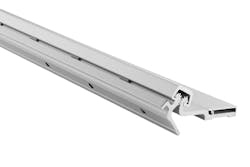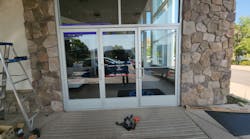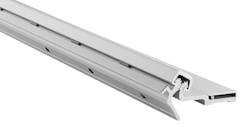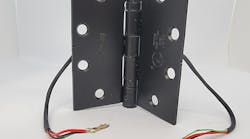There’s a huge market for continuous hinges in the new and retrofit construction markets. Not only do these devices work long after common, ordinary hinges have failed, but they also ensure that the client’s doors will continue to comply with local and state building/fire codes well into the future.
For example, with many hinges, such as butt, flush, bi-fold, pivots, and others, it’s not uncommon to find doors worn to the point where they drag on the top edge of the door frame. Sometimes it’s so bad that they’ll catch the edge of the frame, causing the door not to completely close.
The Importance of Door Closure
Door closure is a major component in life safety. When a fire door fails to close and latch, everyone is automatically at risk if there’s a fire.
"This is against fire code. This door must close and it must latch and you have to have an exit bar to get out. The door closer has to operate properly and the door cannot drag or catch on the frame," says locksmith Rob Kowal of Apopka, Fla.
Doors must fit tightly for several reasons. First, is the issue of smoke control, where isolating sections of a building helps prevent the spread of smoke throughout a structure during a fire situation. Second, it helps to prevent the spread of the fire itself. A door that fails to close can spread both smoke and fire, jeopardizing the well being of occupants in other areas of the structure.
According to Fortress Security of Woking, Surrey of the United Kingdom, “...most doors are required to provide a smoke control function, and all fire doors must be fitted with intumescent seals, which expand greatly with heat, serving to close the gap in the door frame and contain any smoke and flames. It is vital that these are fitted correctly so that not only will they seal this gap as much as possible, but also that they will not hinder the full and effective closure of the door” (http://bit.ly/2LaJsWO).
Stairways are another point of contention when it comes to door closure and life safety. Because it can take an hour or more to evacuate a high-rise building, it’s common practice to pressurize these stairways. This assures clear passage from top to bottom without the presence of deadly smoke. If a door fails to close anywhere along the way, pressurization may not be possible. Smoke may enter and injure or kill those who are trying to evacuate as they move up or down the stairs in an attempt to reach safety.
Often times the weight of a door, combined with an extreme amount of foot traffic, can wear regular hinges out, causing them to sag and catch on the door frame. A full-length continuous hinge will correct this condition almost indefinitely.
Security is another reason to use continuous hinges. This type of hinge is generally more secure than ordinary hinges. This is because they cannot be disassembled by a burglar as is often the case with a common hinge with removable pins. This is because they extend over the full length of the door. The other issue is damaged hinge spaces, such as stripped-out screws, over drilled holes, etc.
n addition, "These doors get so much use that the top hinge [can experience problems]. There's a plate spot welded behind the hinge that begins to twist, causing the door to be out of alignment. So we're going to remove the door, remove the hinges, and we'll install a geared, full-surface continuous hinge," says Kowal.
Types of Continuous Hinges
There are four basic types of continuous hinges on the market today with a couple of variations that you should know about. They are:
- Surface Mount
- Half Surface Mount
- Fully Concealed
- Specialty
All four are available in a variety of materials, such as steel or stainless steel. Two and three are popular, but they’re not as much so as the full-surface mount models. One reason is that surface continuous hinges commonly require the least space between door and frame than the others. The general accepted gap between the door and the frame opposite the hinge of a full-surface continuous hinge is 1/8 inch plus 1/32, or 5/32 inch. With the others, this gap is usually more, which means that it may be impractical to use them in a retrofit situation.
All types of continuous hinges come in an assortment of finishes, such as brass, Nickel, and charcoal--in addition to standard and heavy duty. Most of the time you, as a locksmith, will work with surface-mount continuous hinges--‘pin and barrel’ or geared.
The fourth type is a specialty hinge. They represent specific kinds of continuous hinges designed for specific applications. A good example is a continuous hinge equipped with wired connections for an energized lockset mounted inside the door for access control.
For the remainder of this story, our discussion will center on the surface-mounted continuous hinge.
Installation of the Surface Continuous Hinge
Before you begin retrofitting a door with any type of continuous hinge you need to measure the door and the opening in which it fits. As mentioned earlier, a surface-mounted continuous hinge requires about 5/32 inch between the door and the jamb on all sides. Some locksmiths insert slotted screwdrivers on all sides to shim the door while others make use of tongue suppressors or popsicle sticks. Take your pick.
Consider the following steps as a general explanation of how to install a full-surface continuous hinge in an average door opening. However, always refer to the hinge manufacturer’s installation instructions before proceeding. Also included is a list of manufacturers as well as installation/service tips that follow.
Remove the door from the frame and strip the hardware from it.
- Remove the pivots or other hinges from the door.
- Shim the door on all sides, being careful to maintain proper spacing on all sides.
- Measure the height of the door and cut the continuous hinge accordingly.
- Mount the hinge to the frame first and then the door (Some experts say to mount it first to the door).
- Use the screws and other hardware provided by the hinge manufacturer. Substituting may place the door installation in jeopardy.
- Be sure to use several through-bolts so the door cannot be removed from the continuous hinge from outside. Be sure to space them over the length of the door and frame.
- Where applicable, install a hinge cover over both of the extended leafs.
Installation and Service Tips
Tip #1: Cover the spot where the mortise hinges were installed on the door and door frame. You can buy filler plates or make your own.
Tip #2: Keep a variety of fast-drying spray paints of various colors on hand in the van so you can paint the filler plates or solve any other problem you may have.
Tip #3: You can make filler plates in your shop using a flat piece of aluminum, cutting it to length. Keep a supply of them on the van for occasions such as this.
Tip #4: You also can make a hinge plate by cutting the pin assembly from the flanges that attach to the door and the frame.
Tip #5: Many times the metal frame will be filled with concrete. Instead of using regular drill bits to drill the holes for the continuous hinge, use drill-tip screws because they cost a lot less than drill bits. Then drill the concrete using a regular masonry drill bit.
Tip #6: When preparing to mount the surface-mounted continuous hinge to the door frame, use a sliding combination square and a pencil to draw a line to assure the hinge is straight in reference to the frame.
Tip #7: This may be a good time to install a new threshold. Often times the original weatherseal is worn or its missing altogether.
Tip #8: According to Kowal, the ideal scenario is to place the center bend of the new hinge where the door and the jamb come together. But even when you’re dealing with a half frame situation, the door will open and close perfectly fine.
Tip #9: Install the self-tapping screws that come with the hinge, but add through-bolts along the door to assure that the hinge remains in adjustment for years to come. Space them out along the hinge to assure better security.
Ready sources of continuous hinges:
● ABH Manufacturing | Phone: (630) 875-9900 | Web: https://www.abhmfg.com
● Bommer | Phone: (864)457-3301 | Web: https://www.bommer.com
● C.R. Laurence | Phone: (800) 421-6144 | Web: http://www.crl-arch.com
● Hager Companies | Phone: 877-841-2219 | Web: www.hagerco.com
● ASSA ABLOY Door Accessories (McKinney, Pemko) | Phone: 877-747-6845 | Web: https://www.assaabloydooraccessories.us
● Select Hinges | Phone: 800-585-1019 | Web: https://www.select-hinges.com






